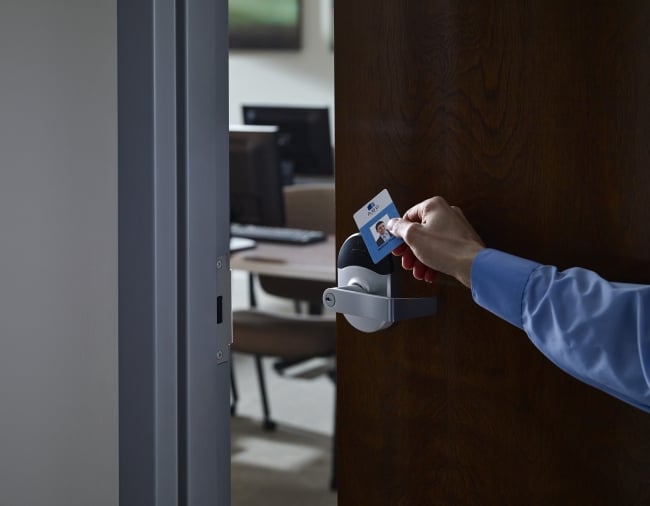You have /5 articles left.
Sign up for a free account or log in.

A student uses a smart card.
Courtesy of Mike Bonifas
Northwestern University will replace dorm keys with smart cards for four residential buildings this fall, with the eventual goal of using smart cards for all buildings. While Northwestern is moving now, the era of the dorm key ended long ago.
Other institutions have already swapped dorm keys for smart cards -- some as early as 2008. And still others have scrapped keys for smartphone apps.
Technological advances are rendering dorm keys more and more obsolete, said Jeremy Earles, business leader of credentials and readers for the security company Allegion and an expert on access control, or the selective restriction of access to a building or place. “There is definitely a trend in the university residence hall space of moving toward smart cards especially,” he said. “Once you have the security of a smart card, you can then easily add the convenience of a smartphone.”
This trend in higher education parallels a trend in the credit card industry, Earles said. Just as more credit card companies are adopting the smart chip to increase the security of transactions, so more institutions are adopting smart cards and smartphones to increase campus safety, he said.
All Northwestern students and employees will be issued redesigned ID cards -- known as Wildcards -- at the start of the semester, said Paul Riel, executive director of residential services at Northwestern. One swipe of the smart card will grant students access to both public spaces and private rooms in four residential buildings, he said.
This new system will effectively heighten campus security, Riel said. “If a student loses a key, there’s certainly a risk,” he said. “Their room is less secure. With the card access, once a lost card is reported to us, we can find out where that card was used and shut it down.”
The eventual goal is to expand the smart cards to all residential buildings within the next five years, he said. But accomplishing this goal could be costly.
“It’s expensive any time you transition from one system to another,” Riel said. Of the cost of the transition to smart cards, he said, “I would imagine we’re probably somewhere in the neighborhood of $2.5 million or $3 million in the next five years. But that might be low, frankly.”
While Northwestern just embraced smart card technology, Hamilton College has been using the technology for nearly a decade. Administrators at the private liberal arts college decided to replace the keys of all residence halls with smart cards called Hill Cards in the fall of 2008.
The decision heightened campus security and streamlined access to different buildings, said Travis Hill, assistant dean of students for residential life at Hamilton. Smart cards allow students to more easily enter their own residence halls, as well as other residence halls at designated times of day, he said.
But whereas smart cards work on the interior doors to private rooms at Northwestern, they only work on the exterior doors to buildings at Hamilton, Hill said. The cost of introducing smart card access for the interior doors of all 27 residence halls would be “astronomical,” he said.
Still, Hill expressed surprise at the fact that Northwestern was using smart cards for the first time this fall. “I am a bit surprised. But in fairness, I’m sensitive to the fact that different campuses have different physical structures, in terms of when it’s most cost-efficient to get into buildings and do the level of wiring that’s necessary,” he said.
“Financially, it’s a huge undertaking whenever a campus decides to do this sort of thing if there’s no electrical structure in place,” Hill added. “When we did it, it was an intentional choice that was planned in advance. If you didn’t have the money or a construction-related project in place, it might take time for that opportunity to present itself.”
Moving beyond smart cards, some institutions let students enter residence halls using a smartphone app. Villanova University first piloted this option in the fall of 2012 in partnership with the companies CBORD and Ingersoll Rand Security Technologies (now Allegion), said John Bonass, assistant director of university card systems at Villanova.
Students at Villanova can download their access assignments from their student ID cards on a smartphone app, Bonass said. Once authenticated, they simply open the app and swipe the card icon to get into a residence hall.
This system has proven effective because millennials rarely part ways with their phones, Bonass said. “Their phone is basically always in their hand or within a couple of feet of them,” he said. “Students just don’t lose their phones like they would lose a master key.”
Villanova has been rolling out this system in phases, said Jonathan Gust, director of media relations. Students can use their phones to access approximately 60 percent of residence halls, and this percentage stands to increase in the future, he said.
A 2012 survey revealed that students are largely satisfied with the system, Gust said. Approximately 91 percent of respondents said the ease of use or convenience of the phone was the best part of the system. More than 70 percent of respondents said they preferred using their phones to enter buildings as opposed to their Wildcards.
Students at Miami University in Ohio can also use a smartphone app offered by CBORD to get into buildings, said Kirk Hopkins, associate director of technology for housing, dining, recreation and business at Miami. While the university has not conducted any formal surveys, the word on campus is that “people think it’s pretty cool that you can just tap to get in,” he said.




